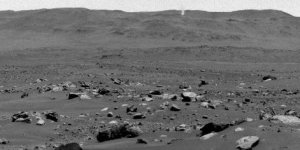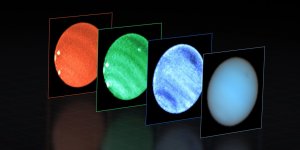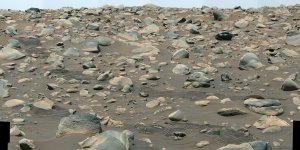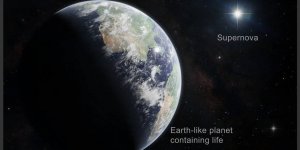Space

The six-wheeled geologist spotted the twister as part of an atmospheric exploration of Jezero Crater. »

Jupiter’s moon Europa is one of a handful of worlds in our solar system that could potentially harbor conditions suitable for life. »

Using ESO’s Very Large Telescope (VLT), astronomers have observed a large dark spot in Neptune’s atmosphere, with an unexpected smaller bright spot adjacent to it. »

With a remarkable observational campaign that involved 12 telescopes both on the ground and in space, including three European Southern Observatory (ESO) facilities, astronomers have uncovered the strange behaviour of a pulsar, a super-fast-spinning dead star. »

A new investigation with NASA’s James Webb Space Telescope into K2-18 b, an exoplanet 8.6 times as massive as Earth, has revealed the presence of carbon-bearing molecules including methane and carbon dioxide. »

After years of anticipation and hard work by NASA’s OSIRIS-REx (Origins, Spectral Interpretation, Resource Identification and Security – Regolith Explorer) team, a capsule of rocks and dust collected from asteroid Bennu finally is on Earth. »

Magnetars are the strongest magnets in the Universe. These super-dense dead stars with ultra-strong magnetic fields can be found all over our galaxy but astronomers don’t know exactly how they form. »

Unusual white dwarf star is made of hydrogen on one side and helium on the other. »

Astronomers have uncovered a link between Neptune's shifting cloud abundance and the 11-year solar cycle, in which the waxing and waning of the Sun's entangled magnetic fields drives solar activity. »

India's Chandrayaan-3 mission's lander module accomplished a successful touchdown on the lunar surface on Wednesday. »

A new paper suggests the same conditions that created the cracks could have been favorable to the emergence of microscopic life. »

Using the Atacama Large Millimeter/submillimeter Array (ALMA), astronomers have found the possible ‘sibling’ of a planet orbiting a distant star. »

Astronomers using Hubble have discovered a swarm of boulders that were possibly shaken off the asteroid when NASA deliberately slammed the half-ton DART impactor spacecraft into Dimorphos at approximately 14,000 miles per hour. »

NASA’s Perseverance Mars rover sealed the tube containing its 20th rock core sample on June 23 (the 832nd Martian day, or sol, of the mission). »

Astronomers using data from NASA’s Chandra X-ray Observatory and other telescopes have identified a new threat to life on planets like Earth. »

An Indian rocket has been launched into space to land a robotic rover on an unexplored part of the Moon. »

Researchers have spotted a planet beyond our solar system, that orbits a sun-like star every 19 hours and appears to be wrapped in metallic clouds made of titanium and silicates that reflect most incoming light back into space. »

Scientists have found evidence of a universal background of gravitational waves, or ripples in the fabric of space-time. »

A team of international scientists has used NASA’s James Webb Space Telescope to detect a new carbon compound in space for the first time. »

An international team of researchers has used NASA’s James Webb Space Telescope to calculate the amount of heat energy coming from the rocky exoplanet TRAPPIST-1 c. The result suggests that the planet’s atmosphere – if it exists at all – is extremely thin. »

Phosphorus, a key chemical element for many biological processes, has been found in icy grains emitted by the small moon and is likely abundant in its subsurface ocean. »

The work is based on new modeling and explores how oceans could exist in unlikely places in our solar system. »

Using ESO’s Very Large Telescope (VLT), researchers have found for the first time the fingerprints left by the explosion of the first stars in the Universe. »

A new NASA study offers an explanation of how quakes could be the source of the mysteriously smooth terrain on moons circling Jupiter and Saturn. »

These objects are more than 100 times brighter than they should be. Observations by the agency’s NuSTAR X-ray telescope support a possible solution to this puzzle. »

Glass beads on the moon's surface may contain nearly 300 billion tons of water, which could provide a way for astronauts on future lunar missions to get water in space, a team of 28 scientists said. »

The secret has been hiding in plain view for 40 years. »

In just a few hours of observations, the space telescope revealed a dynamic atmosphere on a planet 40 light-years from Earth. »

Using the Atacama Large Millimeter/submillimeter Array astronomers have detected gaseous water in the planet-forming disc around the star V883 Orionis. This water carries a chemical signature that explains the journey of water from star-forming gas clouds to planets, and supports the idea that water on Earth is even older than our Sun. »

Research improves search for cosmic dawn radiation, tests theories of galaxy formation. »

In the search for life elsewhere in the Universe, scientists have traditionally looked for planets with liquid water at their surface. But, rather than flowing as oceans and rivers, much of a planet’s water can be locked in rocks deep within its interior. »

The veteran rover captured a dazzling sunset at the start of a new cloud-imaging campaign. »

Space agencies and private companies around the world have been scheduling their own lunar missions to take place over the coming years, and it will be quite complicated having to coordinate with each other when they use different time zones. »

The research uses archival NASA data to show that Venus may be losing heat from geologic activity in regions called coronae, possibly like early tectonic activity on Earth. »

Among other discoveries made by the rover, rippled rock textures suggest lakes existed in a region of ancient Mars that scientists expected to be drier. »